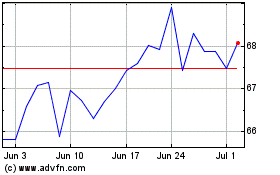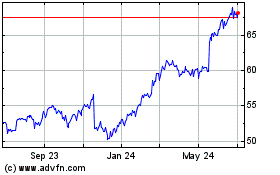Commercial operators were scrambling to keep goods moving as a
massive wildfire east of Los Angeles shut down one of the nation's
major freight corridors for nearly two days, pinching access in and
out of Southern California's busy seaports and inland distribution
centers.
By Thursday, some interstate freeways and rail lines through the
Cajon Pass—key to shipping and commuting between Southern
California and the interior U.S.—had reopened after the Blue Cut
Fire burning on the eastern edge of the Angeles National Forest had
rendered the area impassable Tuesday and Wednesday.
The fire, which started Tuesday, had grown to more than 31,600
acres by Thursday afternoon, and was 4% contained. Temperatures hit
the high 90s and strong winds continue to push the flames. More
than 1,500 firefighters were battling the flames, and 82,000 people
were still under evacuation orders.
At evacuation centers, many anxiously awaited news about the
fate of their homes. Fire officials have said they believe numerous
structures sustained damage.
Evacuations for a community east of the Interstate 15 freeway in
south Hesperia, Calif., were lifted midday Thursday, but it is
unclear when all evacuations will be lifted, said Melody Lardner, a
U.S. Forest Service spokeswoman. Ms. Lardner said it would likely
be a while before all residents can return. On Thursday,
firefighters focused on defending Wrightwood, a small community of
around 4,500 in the San Gabriel mountains.
Lisa Anderson, Inland Empire chapter president of supply-chain
industry group APICS, said that while the delays were short-term,
they could have "a ripple effect" on the shipping industry in the
coming days. Southern California is one of the nation's main hubs
for manufacturing and distribution and home to the nation's two
largest seaports, she said: "Anything that gets delayed here will
affect everywhere else."
BNSF Railway Co. was working through a backlog of trains
Thursday, as two of its three lines through the Cajon Pass had
reopened. Normally the railroad sends 70 trains through the pass
daily, spokeswoman Lena Kent said. "There was traffic that was
holding on both sides of the Cajon Pass so it will take us time to
move through backlog as well as our normal daily traffic," she
said.
When the fire broke out, Ms. Kent said, BNSF deployed three
water trucks and workers to douse the area, which helped the
railroad restore service quickly. "This isn't the first time we've
had a fire in the Cajon Pass," she said.
The railroad estimates a delay of roughly 48 hours maximum for
customers, whose goods move by rail to and from the nation's two
largest ports, Los Angeles and Long Beach.
Union Pacific Corp., which also runs several rail lines in and
out of the ports and through the Cajon Pass, said both ends of its
rail bridge in the area were damaged. The company is working to
replace those sections, a spokesman said.
Union Pacific runs between 40 and 70 trains on those tracks each
day, and has been rerouting trains. Union Pacific spokesman Aaron
Hunt said Thursday the company expects service to be restored
through the Cajon Pass early next week.
For terminal operators at the ports, rail delays can cause
headaches as containers may sit longer at the docks waiting for an
interior-bound train. Ryan Molinaro, a port terminal manager in Los
Angeles, said some export cargo originating in the Midwest and
bound for the port could miss the boat this week if it gets held up
in the Cajon Pass.
But Mr. Molinaro and other terminal managers said they haven't
seen any fallout from the delays as of yet. "Nobody's hitting the
panic button yet," he said.
Shutdowns of the Interstate-15 freeway, which sees roughly 5,500
trucks pass through each day, were clearing up Thursday. Many
drivers were rerouting as much as 100 miles out of the way to avoid
the area, said Eric Sauer of the California Trucking
Association.
"All segments of the industry—from folks servicing construction
sites to Wal-Mart, grocery stores, down to mom-and-pops—they're
feeling the impact," Mr. Sauer said.
Joe Rajkovacz of the Western States Trucking Association said
truck drivers are accustomed to road closures and delays, which
they often face in snowy or stormy weather, or when there are major
accidents or other incidents.
Local residents and commuters were also impacted by the I-15
closures. While the northbound side opened up Wednesday, the
southbound side was cut off until late morning Thursday. Eleven San
Bernardino County schools were closed Thursday.
Fire evacuation centers hosted some travelers who couldn't get
to their homes Wednesday night.
"The people who are in transit or maybe in a car on vacation,
they literally had no place to go," said Larry Fortmuller, who is
working with the American Red Cross at an evacuation center in
Fontana, Calif.
The northbound I-15 is traveled by many Southern California
vacationers en route to Las Vegas. But Las Vegas casino companies
said Thursday that they have seen minimal impact so far from the
I-15 closure. A spokesman for Caesars Entertainment Corp., a major
Las Vegas Strip casino company, said that a few international
customers extended their stay because they didn't want to head back
to Los Angeles through the fire.
Alexandra Berzon contributed to this article.
Write to Erica E. Phillips at erica.phillips@wsj.com
(END) Dow Jones Newswires
August 18, 2016 19:15 ET (23:15 GMT)
Copyright (c) 2016 Dow Jones & Company, Inc.
Walmart (NYSE:WMT)
Historical Stock Chart
From Mar 2024 to Apr 2024

Walmart (NYSE:WMT)
Historical Stock Chart
From Apr 2023 to Apr 2024
